11. ACCESS TO LEGAL SERVICES AND FAMILY REUNIFICATION
Introduction
Description:
This module is designed to strengthen the capacity of frontline professionals working with unaccompanied minors, refugees, and asylum seekers to provide effective legal and procedural support, with a focus on family reunification, age assessment challenges, and access to legal services. Grounded in human rights principles, the course bridges legal frameworks with practical application in transnational and often complex migration contexts.
The module is intended for practitioners, shelter providers, legal advisors, and integration service staff operating in partner countries and globally. It offers actionable tools, real-life scenarios, and reflective exercises to support learners in understanding and navigating legal pathways for unaccompanied minors and those on the move. Combining experiential, self-directed, and problem-based learning approaches, the course prepares participants to engage with legal systems in a way that promotes the protection, dignity, and rights of young people in vulnerable situations.
Aim:
To equip professionals working with unaccompanied minors, refugees, and asylum seekers with the essential legal knowledge and practical tools needed to support young people in accessing their rights. With a focus on family reunification, legal representation, and age assessment challenges, the course bridges theory and practice in contexts where timely, informed action is critical.
Through real-life scenarios and interactive learning, participants will develop a clearer understanding of how to apply legal frameworks, coordinate effectively within multidisciplinary teams, and advocate for the rights and protection of youth on the move.
Learning outcomes:
By the end of this course, learners will be able to:
- Describe key legal rights and procedural safeguards for unaccompanied minors and young asylum seekers.
- Recognize and analyze common legal challenges, including lack of documentation and disputed age assessments.
- Apply relevant legal procedures to assist with asylum claims, appeals, and family reunification processes.
- Collaborate with other professionals to ensure coordinated support for minors in shelters or transit settings.
- Communicate legal information clearly to young people and their support networks.
Understanding the Legal Framework for Unaccompanied Minors and Youth on the Move
This chapter provides a foundational understanding of the legal rights, definitions, and obligations that apply to unaccompanied minors, youth, refugees, and asylum seekers, particularly those who are on the move and may lack documentation or stable support. It introduces key legal definitions, outlines relevant international and EU frameworks, and explains what protections practitioners must ensure in their daily work. This includes both rights in law (asylum, family life, legal aid) and rights in practice (identification, safe reception, legal representation).
The content is designed for shelter providers, caseworkers, and legal advisors who support youth across borders or in reception contexts, in partner countries and across the EU. The module focuses on turning legal principles into practical steps that support young people’s rights, dignity, and safety.
Key Definitions and Legal Status
Legal Principles
- Best Interests of the Child (BIC): This principle is the cornerstone of all decisions concerning children and is enshrined in Article 3 of the UN Convention on the Rights of the Child (CRC). It requires that the child’s well-being, safety, and long-term development be central to all administrative or judicial actions. In the asylum context, best interests assessments must be conducted when making decisions about accommodation, guardianship, age disputes, and family reunification. According to the European Union Agency for Asylum (EUAA), best interests considerations must be individualized and involve child participation whenever possible.
- Right to Apply for Asylum All children—regardless of age, documentation, or legal status—have the right to seek asylum under both international law (1951 Refugee Convention) and EU legislation. This includes access to an individual asylum interview and the right to legal assistance during the process.
- Principle of Family Unity Children have the right to live with their families whenever possible. When unaccompanied, efforts must be made to trace and reunite them with their parents or legal/customary caregivers, if it is in the child’s best interests. This principle is supported by the CRC (Art. 9 and 10) and various EU instruments, including the Dublin III Regulation and the Family Reunification Directive (2003/86/EC).
- Non-discrimination States are obliged to guarantee equal rights regardless of nationality, gender, sexual orientation, disability or immigration status (Convention on the Rights of the Child art. 2).
- Benefit of the Doubt In the absence of evidence regarding age or family ties, it shall be presumed the person is a minor and prioritize protective measures (Committee on the Rights of the Child, General Comment 6)
- Access to Justice All children and adolescents have right to free legal assistance, interpreters, and proceedings adapted to their age and maturity (Brasilia Rules 2008)
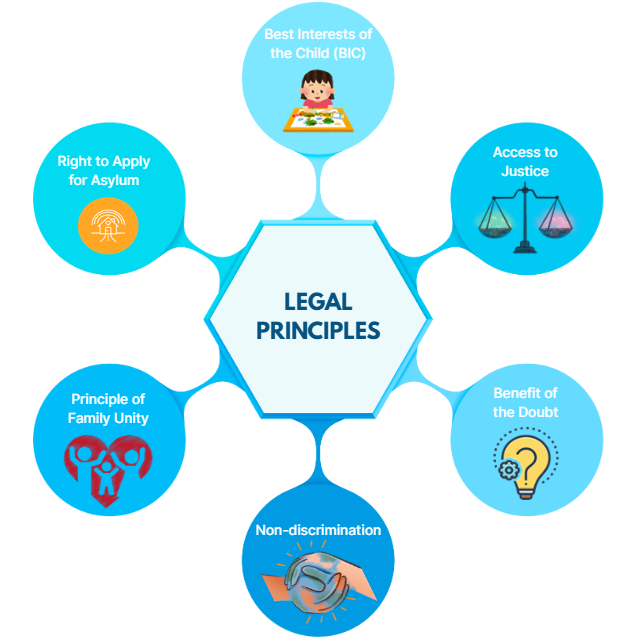
Legal and Procedural Guarantees in Practice
- Identify unaccompanied minors early: This includes at borders, shelters, or transit locations. If their status is not recognized early, children risk being processed as adults or excluded from essential protections.
- Assign a guardian or legal representative: According to EU law (Directive 2013/33/EU, Article 24), unaccompanied minors must be appointed a guardian or representative without delay. This person is responsible for the child’s best interests throughout the asylum procedure.
- Ensure child-friendly procedures: Interviews, forms, and assessments must be adapted to the child’s level of maturity, emotional state, and background. Legal representatives and interpreters should be trained in child-sensitive approaches.
- Provide access to education, healthcare, and housing : Reception conditions must be suitable for children and aligned with their development needs. Large-scale or detention-like facilities are not considered appropriate under EU standards.
- Provide access to temporary Documentation: Provisional identification documents are issued for immediate access to health care, education and shelter pending determination of immigration status.
- Immediate Legal Representation: Children and Adolescents’ Attorney’s Offices act as temporary guardians to guarantee access to asylum procedures without delay.
- Psychosocial Care Linked to Legal Matters: NGOs integrate psychosocial support into legal counseling to reduce revictimization during interviews and proceedings.

Identify unaccompanied minors early
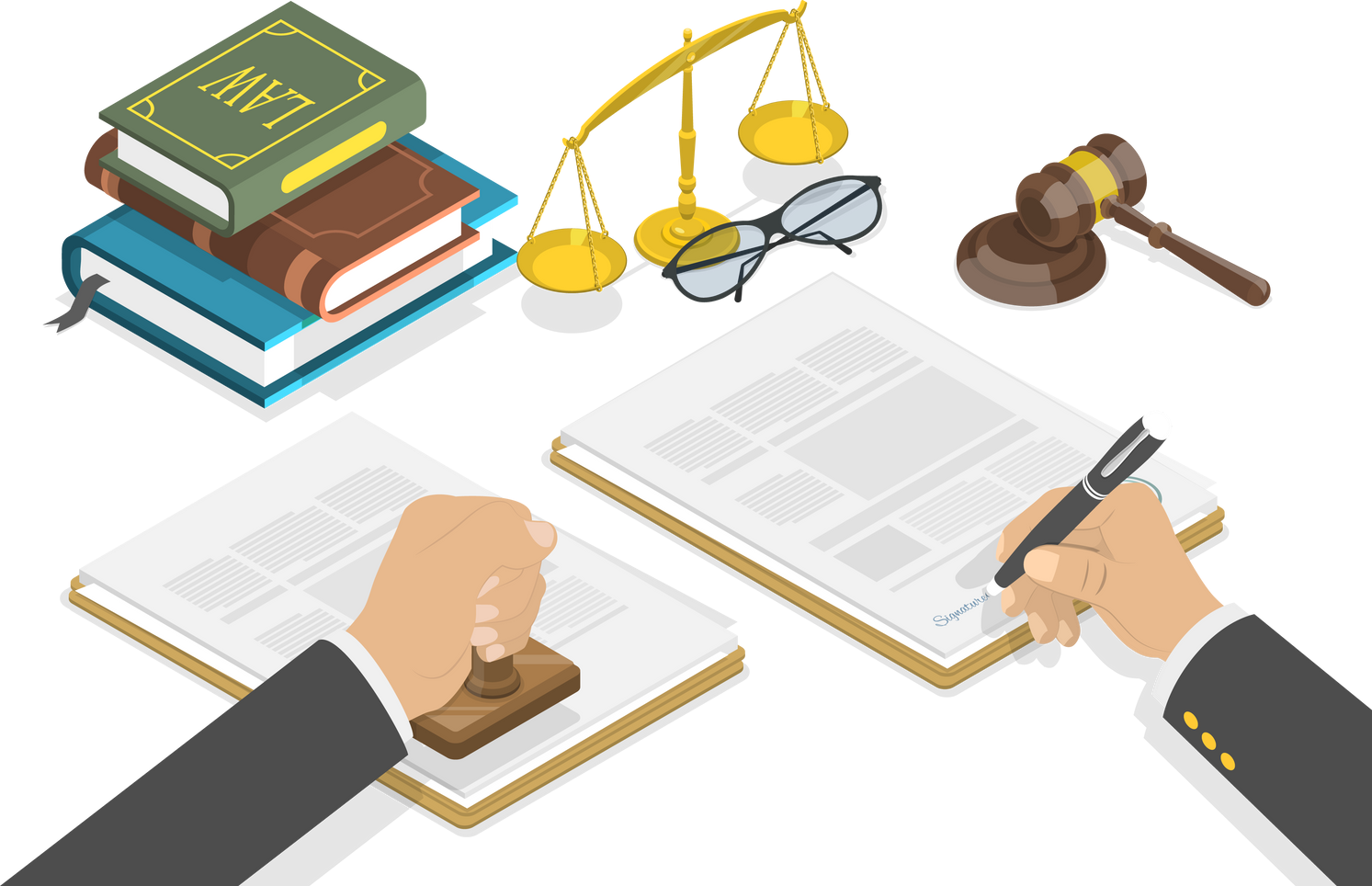
Assign a guardian or legal representative

Ensure child-friendly procedures
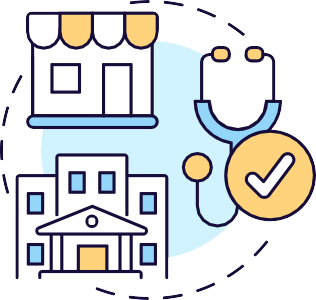
Provide access to education, healthcare, and housing

Provide access to temporary Documentation
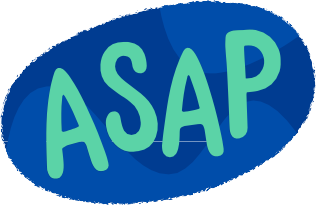
Immediate Legal Representation

Psychosocial Care Linked to Legal Matters
Gaps and Challenges
Despite strong legal frameworks, practical challenges remain:
- Lack of documentation and identification often leads to delayed or incorrect classification. Many minors are not registered as such on arrival, resulting in lost access to child-specific protections.
- Insufficient coordination across sectors (legal, medical, social work) often leads to fragmented support. This is especially problematic for children in transit or those moved between shelters, regions, or countries.
- Practical tool for frontlne teams.
Detected situation | Immediate action recommended | Key actor | Supporting regulations |
|---|---|---|---|
 Child without legal guardian | Request immediate appointment before protection authority | Attorney General’s Office or ombudsmen | CRC art. 20, Migration Law (Mexico), UNHCR Guidelines |
 Family separation | Activate location protocols and precautionary measures to prevent transfer/deportation | UNHCR, NGOs, IOM | CRC art. 9, Opinion OC-21/14 |
 Language barrier | Request a qualified interpreter and mediated cultural assistance | IOM, consulates, NGOs | CRC art. 12 and 13 |
 Risk of return | Invoke the principle of Non-Refoulement and immediate international protection | IOM, UNHCR, ombudsmen, courts | 1951 Convention and CIDH jurisprudence |
Age Assessment and Identity Verification
This chapter examines one of the most sensitive legal and procedural challenges in supporting unaccompanied minors: determining age and identity in the absence of credible documentation. It highlights the limitations of current assessment methods, legal implications of age disputes, and the role of diplomatic channels in identity verification—while emphasizing child protection and the principle of the best interests of the child.
- Most unaccompanied minors arrive without valid ID, birth certificates, or passports. This is often due to armed conflict, displacement, trafficking, or lack of civil registration in their countries of origin.
- Age determines access to child-specific services, legal procedures, reception conditions, and protections against detention or deportation. Mistaken classification as an adult can expose youth to increased risk.
- According to the European Union Agency for Asylum (EUAA), no available method can determine a person’s age with certainty. Common approaches (such as bone or dental scans) are medically and ethically controversial and prone to large margins of error.

Lack of Documentation and Legal Identity

The Importance of Age in Legal Protection

Age Assessment Challenges
Best Practices:
- Use age assessments only as a last resort, and never in isolation.
- Prioritize holistic assessments that include interviews, psychological evaluations, and consideration of the youth’s story and behavior.
- Always inform the child of the procedure in their language and allow legal counsel to be present.
- Presumption of Minority: Upon reasonable doubt, the applicant should be considered a minor until proven otherwise (Committee on the Rights of the Child, General Comment 6)
- Non-Invasive Methods: Assessments shall prioritize psychosocial interviews, behavioral observation, and document review before medical examinations.
- Informed Consent: No test may be performed without explaining the procedure to the child and obtaining their consent (or that of their legal guardian)
- Right to Legal Assistance: The child must have a lawyer or guardian throughout the assessment process.
- Independent Review: Mechanisms must be in place to challenge questionable or inconsistent results.
Role of Embassies and Consular Authorities
In some cases, authorities reach out to the embassy of the child’s country of origin to verify identity or issue documents. However, this must be done with extreme caution:
If a child has been granted asylum, contacting their country-of-origin embassy or consulate is prohibited except in rare, legally approved circumstances.
Why:
- 1951 Refugee Convention & Non-refoulement – No actions that could return or expose a refugee to persecution, even indirectly.
- UNHCR Guidelines – Embassy contact risks revealing location, endangering the child or their family.
- Convention on the Rights of the Child – Best interests and protection of refugee children must come first.
- National Laws – Such contact breaches confidentiality, data protection, and asylum safeguards.
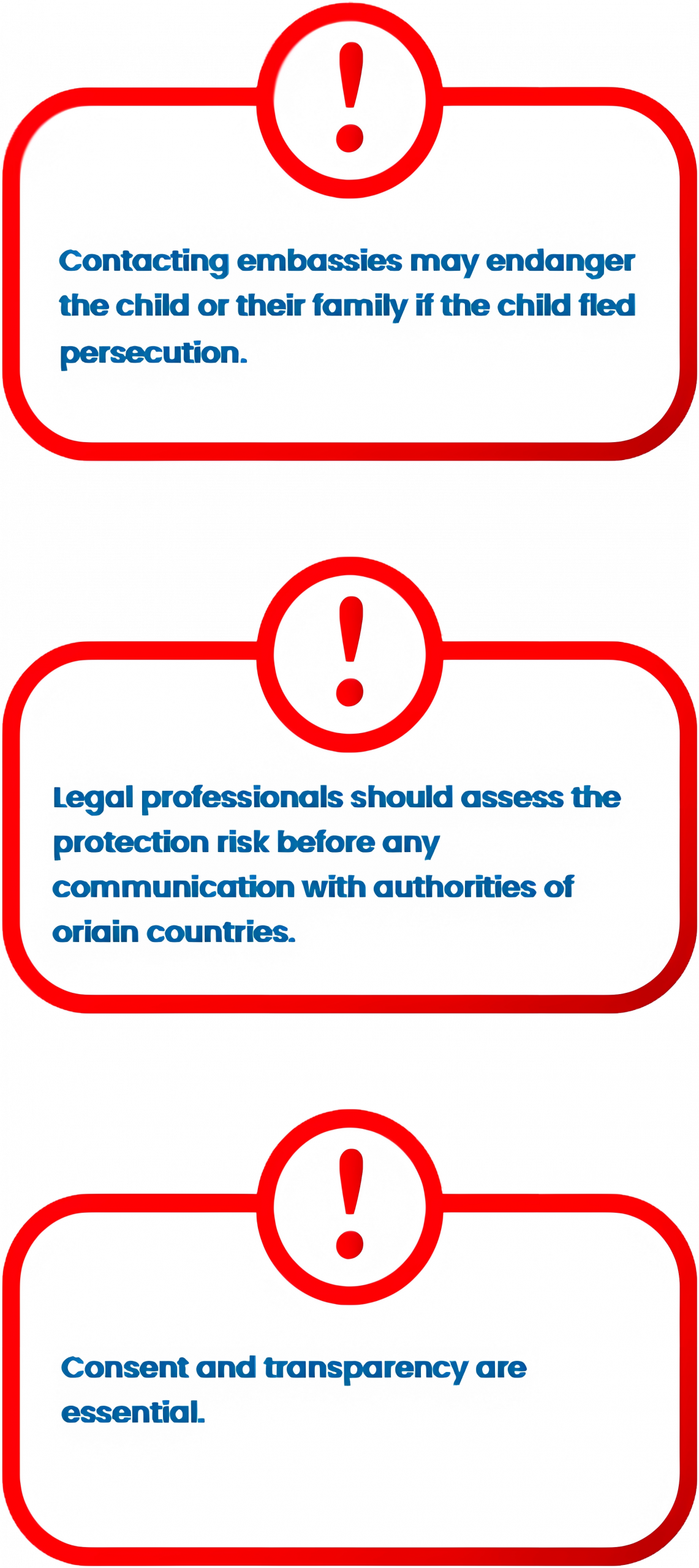

Do not request documents or verify identity via the origin-country authorities.
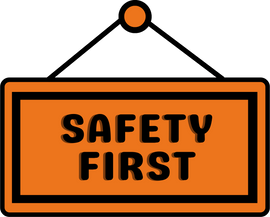
Use safe alternatives (domestic records, UNHCR, trusted NGOs).

Even with consent, protection authorities must assess—and usually reject—such contact.
Steps for an ethical age assessment
Quick Tool: Recommended steps for an ethical age assessment.
Age assessment is not just a technical procedure, it is a decision that has a direct impact on the life of the minor. It can mean access to or exclusion from shelters, education, medical care, and international protection. The priority must be to protect, not to control.
 Step |  Recommended action |  Responsible party |
|---|---|---|
1 | Identify doubt about age and record it in the file | Immigration or protection authority |
2 | Assign a legal guardian and lawyer immediately | Child protection agency(Attorney General’s Office, NGOs) |
3 | Conduct interviews and psychosocial assessment first | Social worker, psychologist |
4 | Avoid invasive medical examinations, use only as last resort | Trained medical personnel |
5 | Ensure the right to appeal results | Public defender’s office, courts |
First-Line Legal Assistance and Empowerment Tools
This course part focuses on how to make legal services visible, accessible, and empowering for unaccompanied minors and asylum-seeking youth. It explores key strategies for building trust, delivering legal information through group sessions, using interpreters effectively, and engaging young people in their own legal journeys.
Key Actions / Principles | Practical Tools / Examples | |
|---|---|---|
 Visible & Accessible Legal Aid | Immediate & free access to legal representation from first contact. Clear introduction upon arrival at shelters. Make services visible (photos, contact info, drop-in hours). Informal & consistent interactions, not only formal meetings. | Posters & flyers in shelters Legal staff regularly visiting common areas. Contact cards for legal aid providers. |
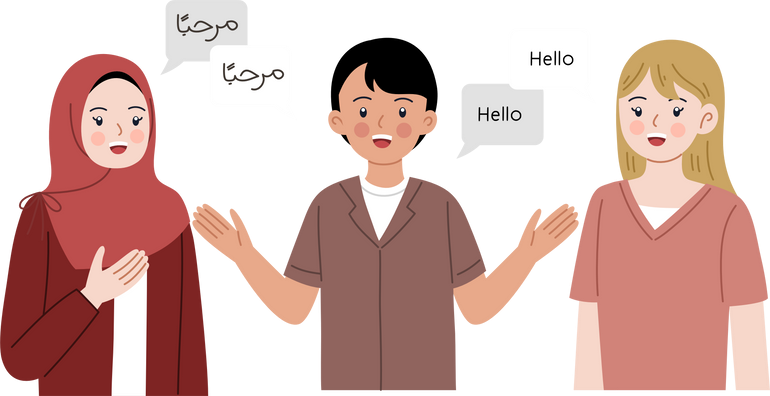 Interpretation as a Safeguard | Interpreters are rights-based partners, not mere translators. Must be trained, gender-sensitive, and emotionally aware. Build trust via small talk. Provide clear, simple, culturally appropriate explanations. | Visual aids & infographics in multiple languages. Use of cultural mediators. Pre-session introductions between minors and interpreters. |
 Group Workshops on Legal Rights | Use peer-led/co-facilitated formats. Explain asylum process & basic terms. How to renew permits, report GBV/trafficking. Inform about rights to education, housing, healthcare. Avoid revictimization & repeated questioning. Ensure active participation of the child. | Role-play exercises. Interactive Q&A sessions. Safe spaces for sharing experiences. |
 Legal Journey Mapping Tools | Use visuals to simplify asylum procedures. Include referral points & checklists. Peer storytelling to normalize challenges. Itinerant Legal Brigades visiting shelters. Ensure no child is left without basic asylum info. Visual booklets (IOM) with drawings & plain language. | Illustrated legal maps. Pocket-sized legal rights booklets. Traveling legal teams in border states. |
Tool: First steps protocol for legal assistance
Quick tool: First steps protocol for legal assistance
This course part focuses on how to make legal services visible, accessible, and empowering for unaccompanied minors and asylum-seeking youth. It explores key strategies for building trust, delivering legal information through group sessions, using interpreters effectively, and engaging young people in their own legal journeys.
The lack of early assistance is one of the main factors leading to deportations, prolonged detentions or family separation. Immediate and coordinated intervention between shelters, NGOs and public defenders is key to protecting fundamental rights.
 Moment |  Recommended action |  Responsible party |
|---|---|---|
Initial reception | Explain basic rights and procedures in clear and accessible language | Shelter staff, legal teams |
First 24 hours | Secure legal guardian or representative, notify the public defender’s office, and register the situation | Office responsible for child development, public defenders, NGOs |
First contact with immigration authorities | Ensure the presence of a lawyer and interpreter, provide refugee or protection application forms | Duty lawyer, responsible for processing asylum applications |
Follow-up | Maintain clear communication about appointments, deadlines, and required documents | Assigned legal advisor, social worker |
Prevention of revictimization | Coordinate to avoid repetitive interviews and offer psychosocial support | Multidisciplinary team |
Besides, it is also important to consider the following:
- Identifying Hidden Vulnerabilities : Legal actors must be trained to spot signs of:
- Trafficking, coercion, or control by others.
- Gender-based violence and trauma.
- Youth at high risk due to rejection, homelessness, or mental health.
- Trauma-Informed Lawyering: A trauma-sensitive approach includes:
- Slowing down, using open body language, avoiding legal jargon.
- Offering space for repetition, silence, and rescheduling.
- Restoring trust in institutions by treating each legal meeting as a moment of dignity
Multidisciplinary & Transnational Coordination in Child Protection
This module examines the critical need for inter-agency, multidisciplinary coordination in supporting unaccompanied minors and youth on the move. It presents how child protection, legal, social, health, and immigration actors must cooperate at local and cross-border levels. It also introduces definitions, institutional frameworks, and best practices for sustainable, rights-based coordination aligned with both IOM and international child protection standards.

Multidisciplinary Team (MDT): Professionals from legal, social, medical, psychological, and guardianship roles working together to conduct best interests assessments and plan durable solutions.

Transnational Protection Mechanism: Coordinated processes across countries (origin, transit, destination) to ensure continuity of care, identity verification, and family tracing or reunification emm.iom.int.
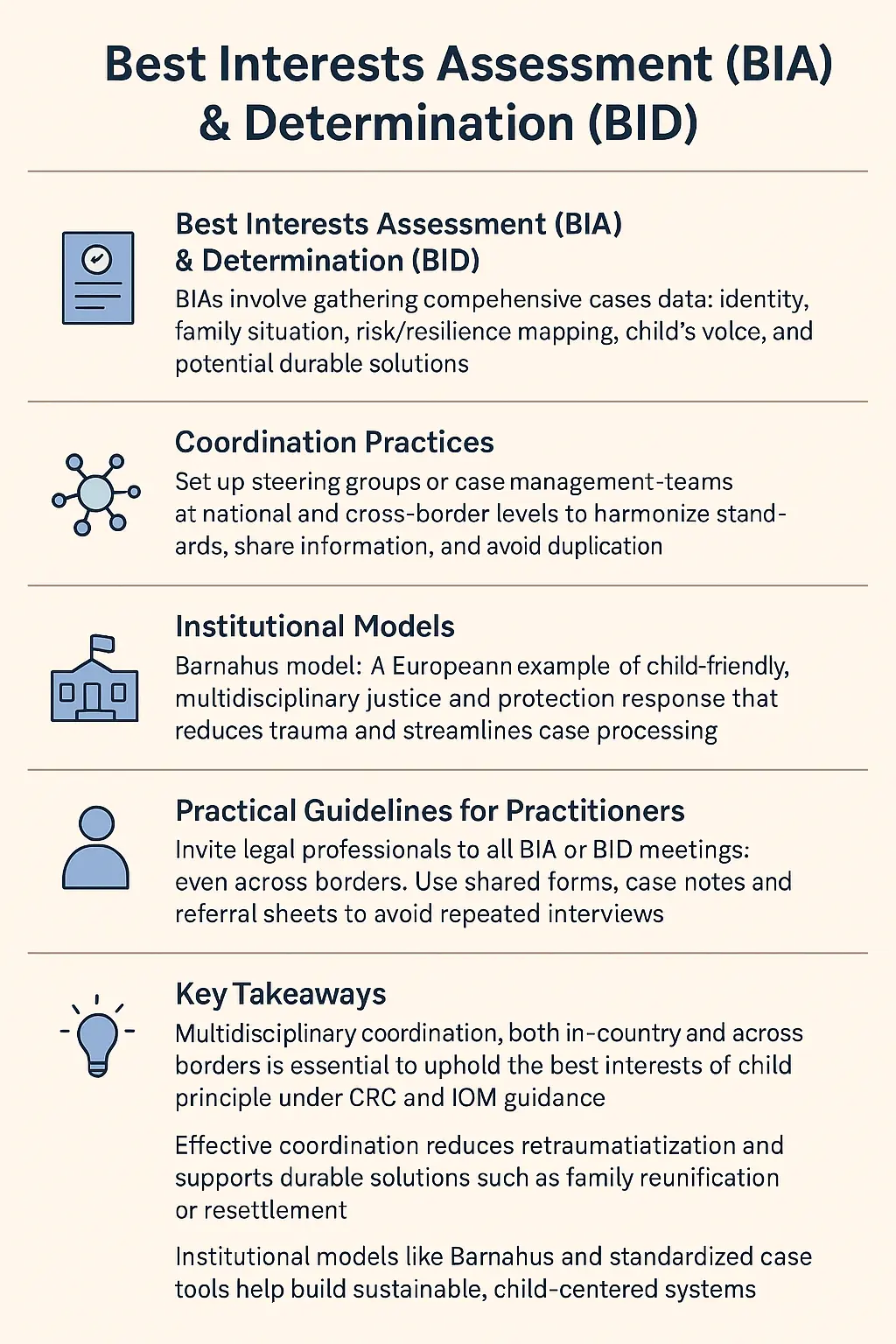
Effective Coordination: Beyond the institutional framework
Although there are legal frameworks and definitions for multidisciplinary teams and transnational protection mechanisms, in practice coordination between actors is often fragmented, leading to delays, duplicate interviews or even unnecessary family separation.
Effective coordination requires clarity in roles, secure communication protocols and mutual trust between government institutions, international organizations and civil society.
In various global and Latin American contexts, three elements have been identified that strengthen this coordination:
- Integrated face-to-face teams: When lawyers, psychologists, social workers, and legal guardians work physically in the same space, contradictions are avoided and the best interests of the child are prioritized.
- Information exchange protocols: Secure, standardized platforms for sharing data between countries make it possible to speed up family reunification, reduce the risk of trafficking and prevent wrongful deportations.
- Direct dialogue with minors: Children shall be involved in decisions about transfers, searching for relatives and protection options. Minimizing unilateral decisions that could affect their well-being.
From Immediate Protection to Durable Solutions
Creating Safe, Stable Pathways for Unaccompanied Minors and Youth on the Move
This final part provides participants with the tools to support durable, rights-based solutions for unaccompanied minors and refugee youth. Drawing on international guidance from the UNCRC, UNHCR, and IOM, it focuses on long-term planning beyond immediate legal aid: from building individual case pathways (like family reunification, regularization, or resettlement) to ensuring continuity of care through cross-sectoral and cross-border cooperation.
It also introduces practical tools for professionals to accompany young people in transitions, and ensure their safe integration or return, while respecting their agency and best interests.
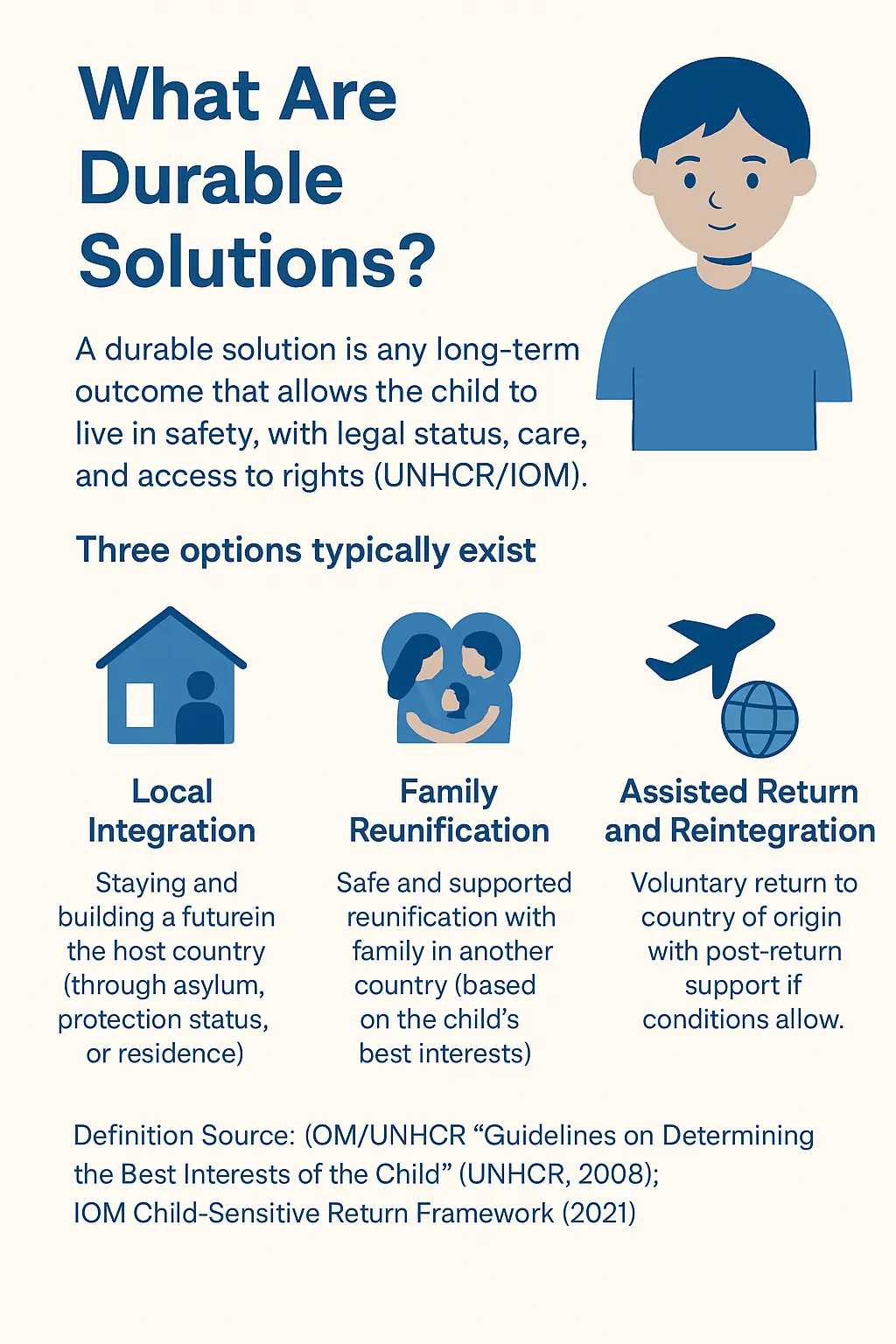
Case Planning & Transition Pathways
Professionals must collaborate early with youth, guardians, and legal experts to build a clear transition plan. This includes:
- Legal Pathway Mapping (residence, appeal, reunification)
- Education and housing access
- Health and mental health support
- Regular check-ins to adjust plan based on changing legal or emotional conditions
Tip: Use visual “Life Path Maps” or “Legal Roadmaps” with the child to help them understand options and rights at each stage.
Supporting Integration or Return
For integration: | For return (only if voluntary and rights-respecting: |
|---|---|
Help youth register in school, get ID/residency cards, and connect with mentors Coordinate with municipal services to secure housing, language classes, and employment support. | Ensure child protection agencies in the country of origin can provide follow-up. IOM guidelines require pre-departure planning, safe reception, and post-return monitoring. |
Caution!: Return should never be coerced, and only done when safe, dignified, and in the child’s best interests. | |
Youth Empowerment in Decision-Making
Durable solutions must
- Be child-informed and child-participatory
- Reflect evolving maturity and wishes
- Build on strengths (language, social networks, resilience)

Be child-informed and child-participatory

Reflect evolving maturity and wishes

Build on strengths (language, social networks, resilience)
Professionals should:
- Use child-friendly formats when presenting options.
- Allow time and space for youth to reflect.
- Include cultural mediators or peer mentors in conversations.
Monitoring, Follow-Up, and Referral
A successful transition requires:
- Scheduled follow-up (every 3–6 months)
- Referral systems across sectors (legal, health, education)
- Updating the Best Interests Determination (BID) if the child’s situation changes
Key Takeaways:
- Durable solutions are central to legal and protection work with unaccompanied minors.
- Transitions must be carefully planned, child-centered, and monitored over time.
- Professionals should empower youth to understand and co-decide their path.
Beyond Immediate Protection: The importance of early planning
While initial care for unaccompanied children and adolescents tends to focus on safety, accommodation and legal representation, the ultimate goal should be to ensure stable and lasting solutions that prevent new situations of risk or forced mobility in the future.
Global experience shows the first days are crucial in determining safer life trajectories. Delays in establishing legal guardianship, documentation, and family reunification routes increase the risk of disappearances, trafficking, exploitation or forced returns. Therefore, protection teams must work from the outset with a medium and long-term vision.
Common challenges to achieving lasting
- Slow bureaucratic processes: Regularization and family reunification procedures can take years.
- Lack of cross-border coordination: Each country operates with different criteria for proving family ties.
- Limited access to education and employment: Without prospects for local integration, minors and their families may be forced to migrate again.
- Insufficient follow-up: Many children lose institutional support after obtaining legal status or after reunification, remaining vulnerable to further violence.

Slow bureaucratic processes: Regularization and family reunification procedures can take years.

Lack of cross-border coordination: Each country operates with different criteria for proving family ties.

Limited access to education and employment: Without prospects for local integration, minors and their families may be forced to migrate again.

Insufficient follow-up: Many children lose institutional support after obtaining legal status or after reunification, remaining vulnerable to further violence.
Recommendations to strengthen long-term protection
- Implement accelerated international reunification procedures, especially for children and adolescents with close relatives in other countries, in accordance with the standards of international human rights protection agencies.
- Facilitate early regularization and documentation to ensure access to education, health care and social programs.
- Establish community support networks and mentors for newly regularized or reunified minors, preventing their isolation.
- Monitor cases for at least the first year, ensuring the solution adopted actually improves their living conditions and does not lead to new violations.
Case study
-Meet a young woman from Sierra Leone who first came to Velos at the age of 17. Pregnant and a victim of gender based violence, she faced immense challenges. Recognizing her urgent need for protection and support, we referred her to a shelter for minors and informed the General Secretary for Minors about her situation. While she was a minor, she was represented by a lawyer from the shelter. Upon turning 18, she returned to Velos seeking continued legal support. As an adult, she needed assistance with various aspects of her new life. We provided support in obtaining her social security number and her employment number. Additionally, she had two appointments for interview preparation, though her interview was postponed twice. Throughout this period, her baby was registered to her asylum case, ensuring that her child would also receive protection. She also received legal counseling on employment issues, helping her navigate the complexities of the labor market as a young mother. Now, she is a young working mother, optimistic and thrilled for her future, embodying resilience and hope as she moves forward with her life.
-Xyla initially came to Velos to seek legal information regarding his rejected asylum application. We applied for a subsequent application, and fortunately, we managed to secure a registration appointment for October 2023. In the meantime, Xyla’s documents had expired, and the only proof of his legal residence in Greece was the certificate of his appointment for the registration of the subsequent application. Unfortunately, he was arrested by the police at the beginning of May and was subsequently placed under administrative detention at a detention centre. We objected to the decision of the police authorities to detain him, providing them with declaring his young age. As a result Xyla was released, and the registration of his application is now pending.
-S.A. was in urgent need to renew his documents swiftly, as the standard procedure for renewal typically takes up to 10 months. This delay would have jeopardized his ability to visit his sister in Sweden, a trip crucial for his mental well-being and family reunification. Additionally, his precarious legal status heightened his anxiety, further exacerbating his psychiatric condition.
Legal Intervention: Upon taking on the case, the lawyer assessed the situation and identified the need for a request to expedite the procedure due to S.A.’s medical condition. A comprehensive application for a renewed decision was submitted, including supporting documentation from medical professionals attesting to the urgency of his case.
In collaboration with the lawyer, S.A. completed the three-step procedure for renewal:
- Application for a renewed decision.
- Fingerprinting for biometric verification.
- Final decision delivery.
The submission emphasized the medical urgency and the necessity for swift processing. Thanks to the lawyer’s intervention, S.A.’s request for an expedited procedure was accepted, and the decision was issued significantly faster than the usual timeline.
Outcome: S.A. successfully obtained his renewed decision, enabling him to apply for a travel document and pursue his goal of visiting his sister in Sweden. The case highlights the critical importance of legal advocacy in navigating complex bureaucratic processes, especially for vulnerable individuals with urgent needs.
Reflections: This case underscores the importance of timely and effective legal support for vulnerable asylum seekers. Early intervention and strong supporting documentation can lead to successful outcomes even in challenging scenarios. However, the lengthy standard procedures remain a pressing issue, often incompatible with the urgent needs of vulnerable individuals. Ensuring expedited processing for medical cases must be a priority to safeguard the rights and well-being of asylum seekers.
Further reading, Sources and References
- European Union Agency for Asylum (EUAA): Reception Conditions for Unaccompanied children
- United Nations Convention on the Rights of the Child (CRC), 1989
- EU Directive 2013/33/EU (Reception Conditions)
- EU Directive 2013/32/EU (Asylum Procedures)
- Dublin III Regulation (EU No 604/2013)
- European Commission: Action Plan on Integration and Inclusion (2021–2027)
- EUAA Age Assessment Guidance (2023)
- UNHCR Working with Unaccompanied and Separated Children: A Field Handbook
- IOM Toolkit on Unaccompanied Children and MIgrants Protection & Assistance guidance
- EASO Practical Guide on Best Interests & Age Assessment
- UNHCR (2022). Working with Unaccompanied and Separated Children: Field Handbook
- EUAA (2023). Practical Guide on Age Assessment
- Convention on the Rights of the Child (CRC)
- IOM (2021). International Migration Law: Glossary on Migration
- UNHCR (2008) Guidelines on Determining the Best Interests of the Child
- IOM (2021) Child-Sensitive Return and Reintegration Guidelines
- EUAA (2023) Practical Tools for Durable Solutions in Child Protection
- UN Committee on the Rights of the Child, General Comment No. 14 on the Best Interests of the Child (2013)
- AMERA International (2023). Trauma-Informed Lawyering Guidelines
- EU Anti-Trafficking Directive 2011/36/EU
- AIDA (Asylum Information Database) – Country Reports
- UNHCR & IOM Manuals on Child Protection
